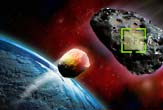New Cosmic Defense Idea: Fight Asteroids with Asteroids - space.com

http://www.space.com/scienceastronomy/060620_science_tuesday.html
By Robert Roy Britt
Senior Science Writer
posted: 20 June 2006
06:06 am ET
In a Space Age version of fighting fire with fire, French scientists have suggested using one asteroid to destroy another rather than letting Earth get pummeled.
The offbeat plan is intentionally incomplete and would allow the planet to be showered by fragments. But it might be better than a civilization-ending whack.
No asteroids are presently known to be on collision courses with Earth. But existing holes in the ground suggest that inevitably one will eventually be found. There is no firm plan for how to deflect or destroy an incoming asteroid, though scientists have pondered firing rockets at them, moving them gently with solar sails, or nudging them with nuclear explosions.
Lock and load
The new idea is to capture a relatively small asteroid—perhaps 100 feet (30 meters) wide—by sending a robot to it.
The robot would heave material from the asteroid's surface into space, and the reaction force would gradually direct the asteroid to a Lagrange point, one of a handful of nodes along Earth's orbit where the gravity of Earth and the Sun balance out. Scientists know that objects can be kept stable at a Lagrange point with little or no energy.
The captured rocky weapon would be held there, traveling around the Sun ahead of or behind the Earth, held until needed.
Then, if a large asteroid threatens to hit us, the small one is moved into its path, using the same heaving technique. The rocks collide, and the big one is broken into somewhat less harmfull bits.
The collision disperses the fragments of the incoming asteroid, so that not all of them hit the planet.
But …
Depending on the relative masses of the two objects, between 10 and 20 percent of the incoming asteroid mass would still hit, "but the fragments would be dispersed all over the Earth and, hopefully, none would be large enough to reach the ground with a large remaining destructive power," said Didier Massonnet of the CNES research center in France.
Massonnet and colleague Benoit Meyssignac say the collision should be engineered to occur at least 620,000 miles (1 million kilometers) from Earth and would take about eight months to execute from the Lagrange point.
The plan is detailed in the July-September, 2006 issue of the journal Acta Astronautica. The researchers first floated it at a scientific conference last fall.
One small asteroid that could fit the bill already been identified; it is called 2000 SG344, and Massonnet suspects there are many others that would work.
Fuel for thought
The researchers admit their entire scheme is not quite ready for prime time.
"We are more confident in our capability to capture the asteroid than in our capability to redirect it to an incoming body," Massonnet told SPACE.com. "The scenario of this last stage requires further studies on the very unstable trajectories which will be required."
Meanwhile, there is another aspect to the plan that could make it appealing.
Material mined from a small, nearby asteroid could provide liquid oxygen for other space missions more efficiently than mining it from the Moon, which other researchers have proposed. Liquid oxygen could be used as fuel at a cosmic gas station that would allow spacecraft to be launched from Earth with much smaller tanks and therefore more cheaply.
Other researchers have suggesting mining asteroids for their metals.
"Several thousands of tons of oxygen might become available sitting on the outer rim of Earth's gravity field," the researchers write.
Gallery: Earth’s Meteor Craters
Mystery of Arizona's Meteor Crater Solved
Mission Possible: Asteroid Tugboat Backed for Trial Run
Catastrophe Calculator: Estimate Asteroid Impact Effects Online
Supercomputer Takes on a Cosmic Threat
Riches in the Rubble: Mining Asteroids

0 Comments:
Post a Comment
<< Home